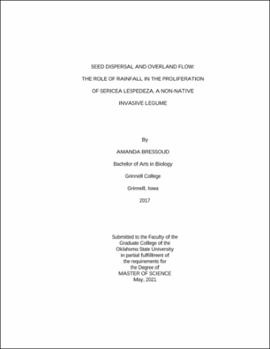| dc.contributor.advisor | Murray, Bryan | |
| dc.contributor.author | Bressoud, Amanda | |
| dc.date.accessioned | 2021-09-24T13:58:04Z | |
| dc.date.available | 2021-09-24T13:58:04Z | |
| dc.date.issued | 2021-05 | |
| dc.identifier.uri | https://hdl.handle.net/11244/330925 | |
| dc.description.abstract | Sericea lespedeza is an invasive legume native to eastern Asia. Although it was initially introduced for forage and erosion control, it has since become a widespread problem, especially in prairie areas, forming dense monocultures and reducing abundances of more palatable native plants. While much work has been done on identifying methods of controlling sericea, less is known about the biology of the plant itself. One particular knowledge gap concerns the methods by which sericea seeds are dispersed. It has been suggested that water, specifically overland flow, may play a role in sericea's dispersal. To test this hypothesis, I set out transects at Oklahoma State University's Range Research Station, and the Joseph H. Williams Tallgrass Prairie Preserve, with six seed traps per transect. Each transect consisted of six seed traps located downslope from a patch of sericea. Slope and sericea density varied for each transect, from 2 degree to 16 degree slope, and 10% to nearly 100% upslope sericea. I also set out batches of UV tagged sericea seeds along slopes of varying intensities at the Range Research Station and monitored their movement across a 1-m quadrat. Seed movement was compared with rainfall data obtained from the local Mesonet station. Both experiments were analyzed using generalized linear mixed modeling (GLMM). Seed counts in the traps decreased with distance from the sericea patch, though slope did not affect seed numbers. UV tagged seeds also were more likely to be found within 50cm from their starting location, and were more affected by rainfall quantity when close to their source as well. Rainfall is likely a vector for the dispersal of sericea seeds, though its impact does not appear to be affected by slope. New sericea seedlings are most likely to germinate in areas adjacent to existing patches, but seeds can still disperse up to at least 7-m away, a further distance than has been previously reported. | |
| dc.format | application/pdf | |
| dc.language | en_US | |
| dc.rights | Copyright is held by the author who has granted the Oklahoma State University Library the non-exclusive right to share this material in its institutional repository. Contact Digital Library Services at lib-dls@okstate.edu or 405-744-9161 for the permission policy on the use, reproduction or distribution of this material. | |
| dc.title | Seed dispersal and overland flow: The role of rainfall in the proliferation of sericea lespedeza, a non-native invasive legume | |
| dc.contributor.committeeMember | Fuhlendorf, Samuel D. | |
| dc.contributor.committeeMember | Goodman, Laura E. | |
| osu.filename | Bressoud_okstate_0664M_17212.pdf | |
| osu.accesstype | Open Access | |
| dc.type.genre | Thesis | |
| dc.type.material | Text | |
| dc.subject.keywords | lespedeza cuneata | |
| dc.subject.keywords | overland flow | |
| dc.subject.keywords | seed dispersal | |
| dc.subject.keywords | sericea lespedeza | |
| thesis.degree.discipline | Natural Resource Ecology and Management | |
| thesis.degree.grantor | Oklahoma State University | |
